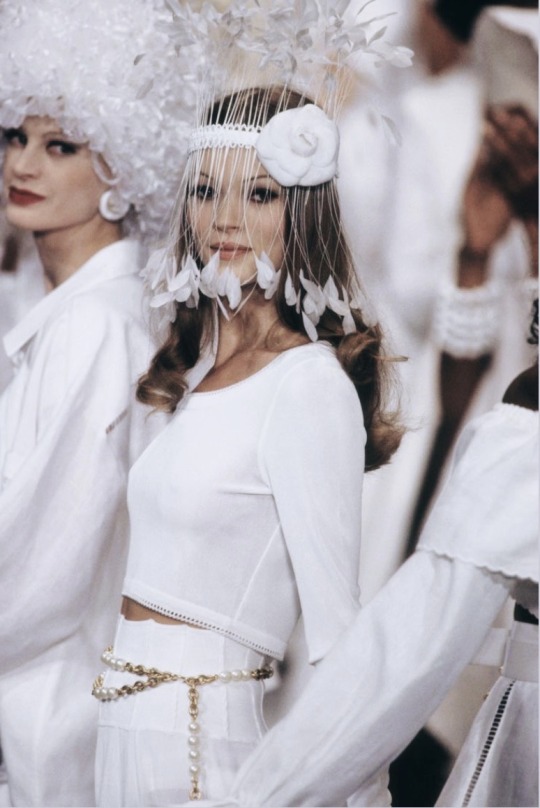#bridal runway 90s
Text
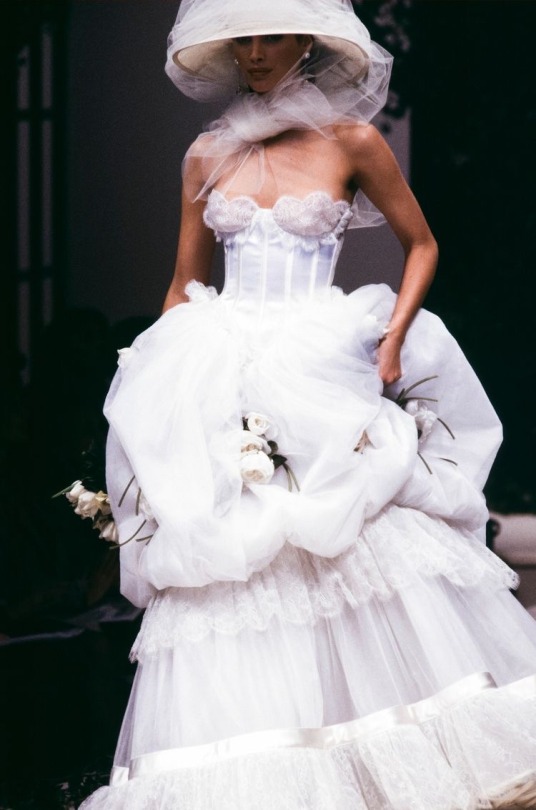
Christy Turlington, Valentino SS 1993 HC
-
#voguesplum#christy turlington#Valentino ss 1993#haute couture#runway fashion#90s supermodels#vintage valentino#fashion runway#Valentino bridal#bridal runway 90s#high fashion#runway model#original supermodels#runway makeup#runway hair#90s runway#vogue 90s#runway couture#bridal couture#coquette runway
485 notes
·
View notes
Text
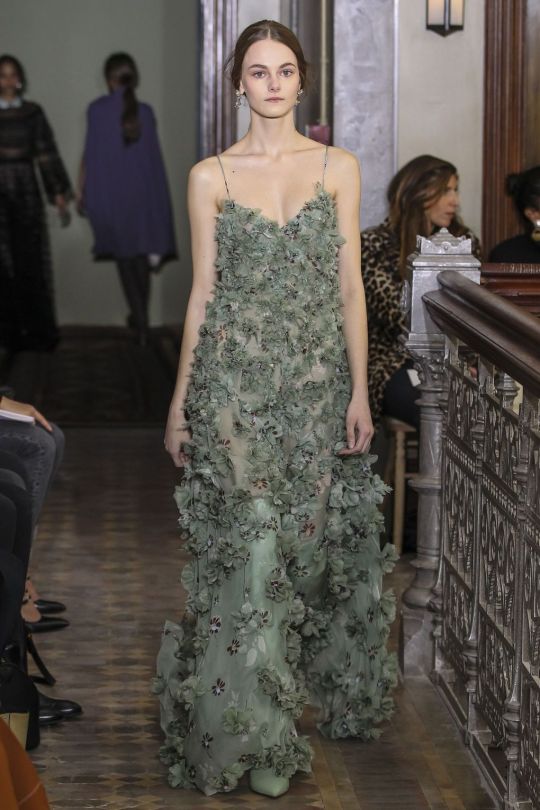

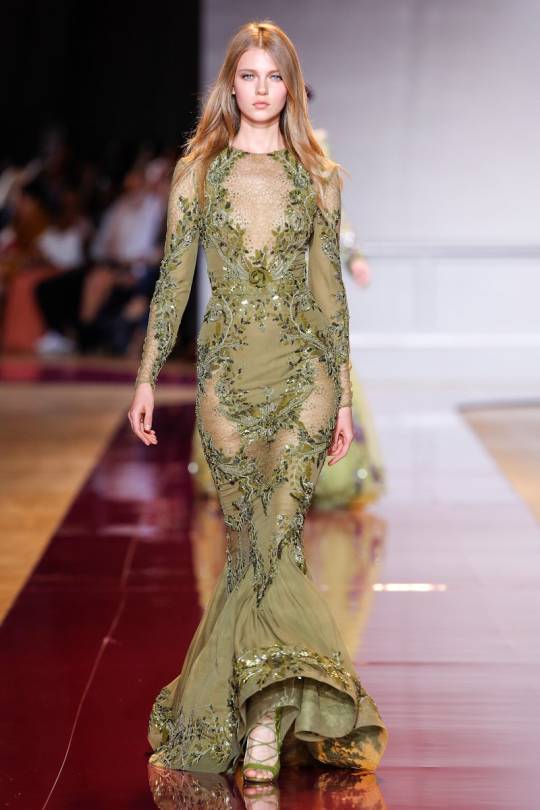



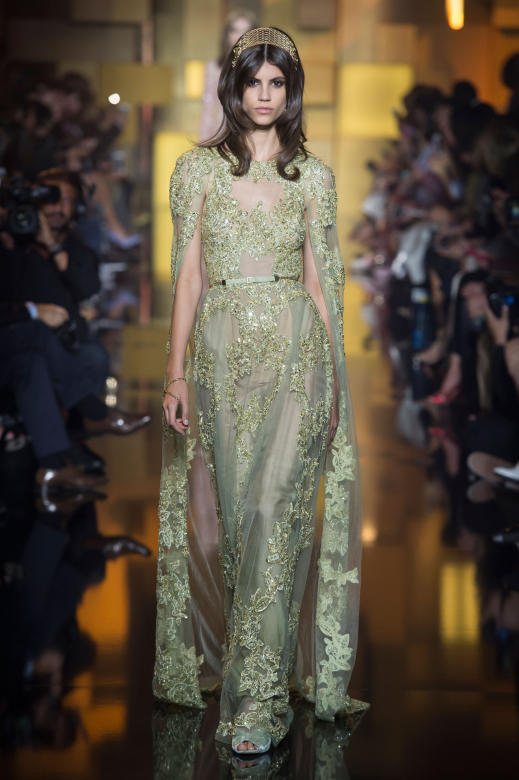


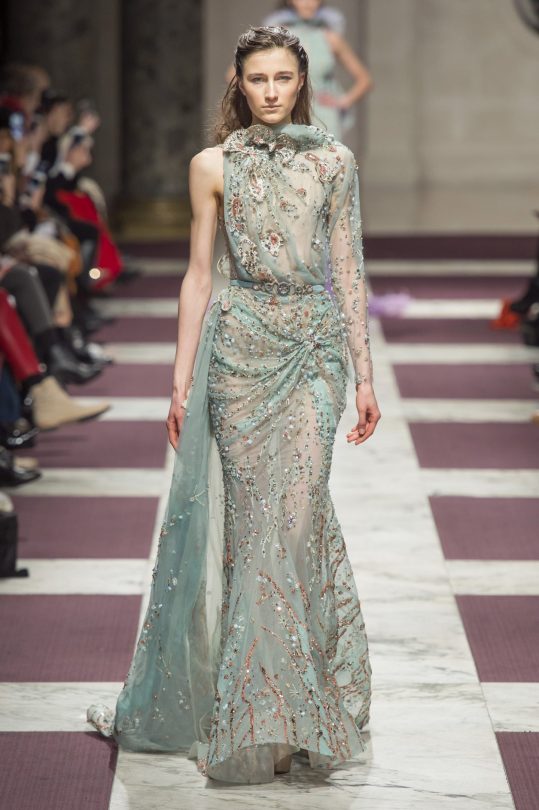

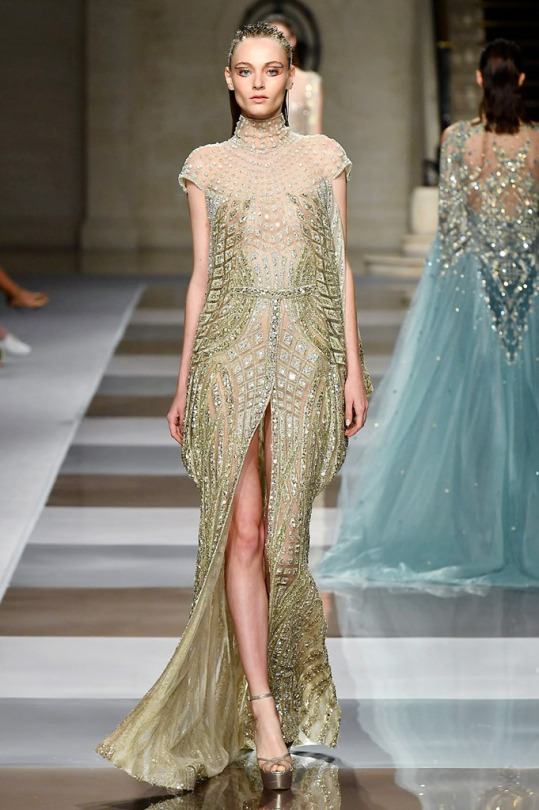
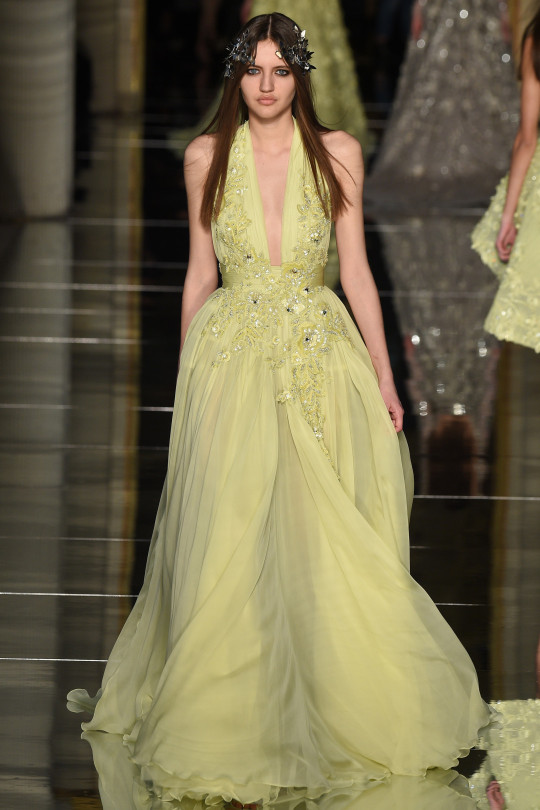

#brownsugar4hersoul#soul candy#sugar for the soul#eye candy#soul food#runway#zuhair murad#zuhair murad fall 2023 couture#floral dress#runway look#bridal runway 90s#fashion runway#runway couture#runway details#runway fashion#runway model#vogue runway#rtw#couture#gowns#floral gown#floral wedding dress#haute couture#bridal couture#couture ss23#couture week#elie saab haute couture#paris haute couture#spring 1996 couture#spring 1997 couture
36 notes
·
View notes
Text

Emanuel Ungaro Fall 1995 Haute Couture
#emanuel ungaro#fashion#fashion week#runway#runway show#fashion show#couture#haute couture#bridal#fashion details#90s fashion
2K notes
·
View notes
Text
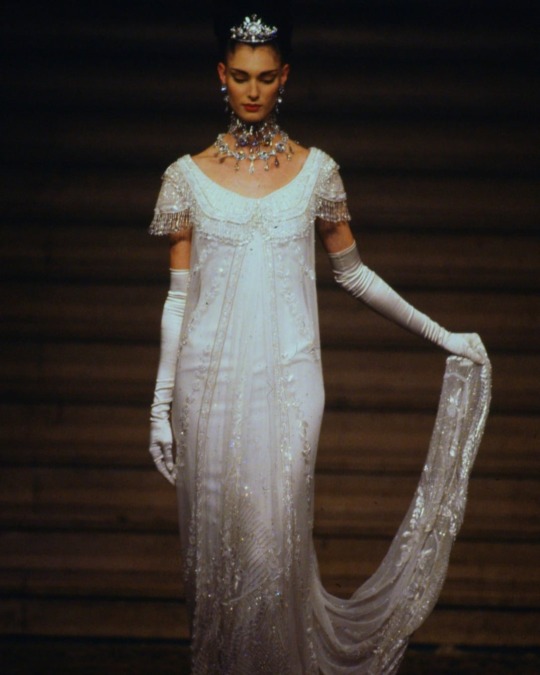
Givenchy by Alexander McQueen: Fall (1997)
#givenchy#alexander mcqueen#fashion#bridal#1997#fw97#fall winter#princess#royal#princesscore#vintage#vintage fashion#clothes#dresses#aesthetic#90s#1990s#runway#designer#haute couture#couture
229 notes
·
View notes
Text

Jean Paul Gaultier ss 2008
Has me wanting to go down the aisle asap…
#00s fashion#fashion#hftwt#runway#90s fashion#vintage gaultier#jpg#jean paul gaultier#bridal#wedding#shoes#issey miyake#marithé + françois girbaud#dries van noten#alexander mcqueen#it girl
105 notes
·
View notes
Text


Claudia Schiffer with Karl Lagerfeld, Chanel’s fall 1992 couture collection 👰🏼
#claudia schiffer#vintage chanel#chanel bride#90s chanel#chanel#fashion#90s#1990s#karl lagerfeld#bridal#bridal dress#white dress#chanel dress#vintage bride#style#runway fashion#fashion runway#runway show#90s runway#couture#haute couture#fashion couture#fashion details#fashion design
136 notes
·
View notes
Photo

#fashion#bridal#cindy crawford#80s#wedding#wedding dress#bride#supermodel#original supermodels#supermodels#rtw#90s style#90s#90s fashion#runway#runway show#model#models#haute couture#couture
83 notes
·
View notes
Text
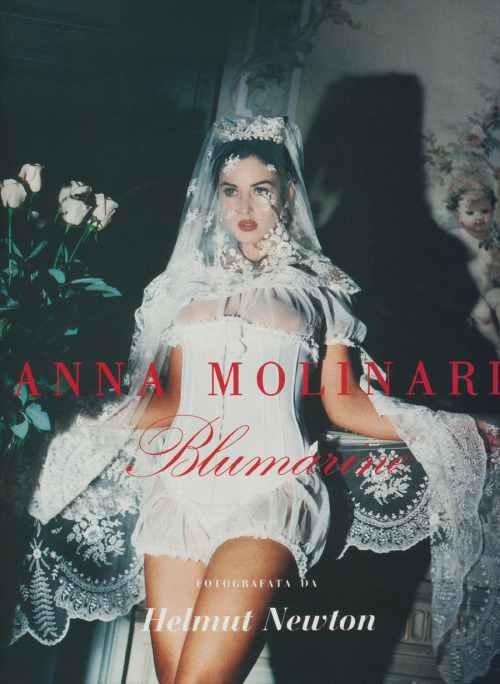
Monica Belluci for Anna Molinari Spring/Summer 1993 ph. Helmut Newton
#runway#runway fashion#fashion campaigns#fashion editorials#Helmut Newton#fashion#luxury fashion#actors#film#Monica Belluci#Blumarine#Miss Blu#Anna Molinari#photography#1990s#90s#90s fashion#90s magazines#1993#bridal#bride#lace#white#lingerie#Italy
88 notes
·
View notes
Text
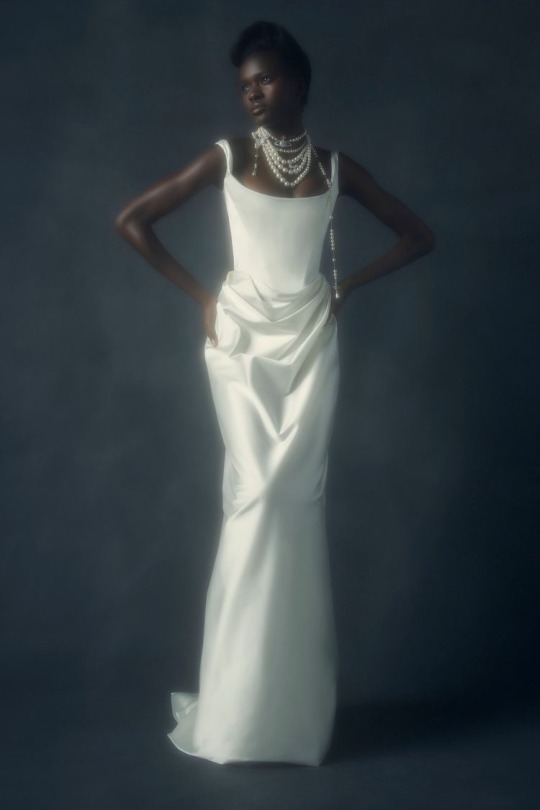

Vivienne Westwood, Bridal 2022. 🤍
#modeling#model#fashion#runway#models#style#vivienne westwood#fashion trends#bridal#bridal collection#body image#girls#90s#90s fashion#90s runway#90s look#2000s fashion#bridal dress
9 notes
·
View notes
Text

Carmen Kass at the Victoria’s Secret Fashion Show 1999 in New York City
#carmen kass#victoria's secret#lingerie#stockings#1990s#90s supermodels#90s runway#runway#bridal#bride#victoria's secret fashion show#victoria's secret angel#angel wings#90s fashion
25 notes
·
View notes
Text
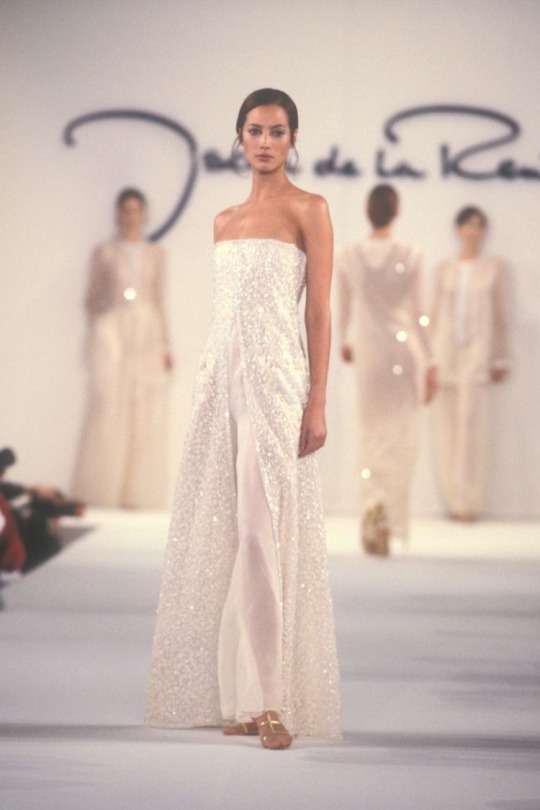
Christy Turlington | Oscar de la Renta, spring 1994 RTW
-
#voguesplum#christy turlington#oscar de la renta#1994#runway 1994#bridal#bridal fashion#runway fashion#vintage fashion#high fashion#fashion#fashion photography#bridal photography#Oscar de la Renta bridal#Christy Turlington runway#Christy Turlington 90s#bridal 90s#90s runway#bridal runway 90s
13 notes
·
View notes
Text
Mini Lolita Fashion History Lesson: MILK
Today, MILK is generally known as an 'otome' or 'girly' brand, and many of their modern items don't look like what modern lolita think of as lolita.
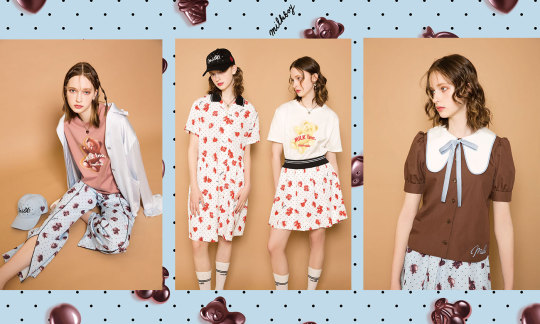
A recent MILK collection
However, in the late 80s and early 90s, MILK was considered to be one of the quintessential Lolita brands.


1990s lolita wearing MILK
In a 1994 zipper interview about the history of lolita fashion the brand representative for MILK states "I think what is now called lolita fashion is the fashion that milk has been making for a long time."
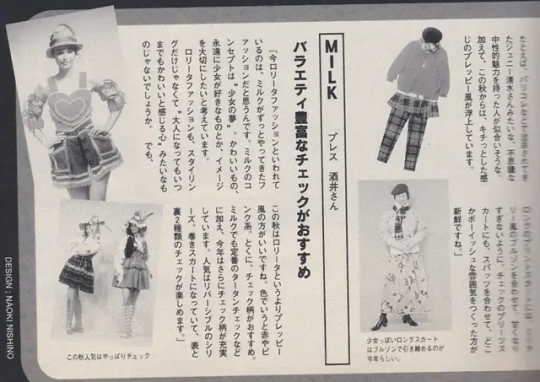
MILK was founded in 1970 by Hitomi Okawa (大川ひとみ). When Hitomi Okawa started as a designer there were not many DC brands yet and ready to wear fashion was really just starting to become more widespread in Japan. Okawa attended an art university in Kyoto because of a love of drawing that started in elementary school. She used to draw illustrations of girls and make things like paper dolls. At the age of 11, she drew many pictures of the same clothes and changed the patterns (polka dots, checks, flowers). She grew up the daughter of a doctor, in an affluent home where her mother would read magazines like Harper's Bazaar with 1950s and 1960s American fashion. She also looked at American fashion catalogs as a child, and cites this study of clothing in magazines and catalogs as her earliest sort of "studying" of fashion.

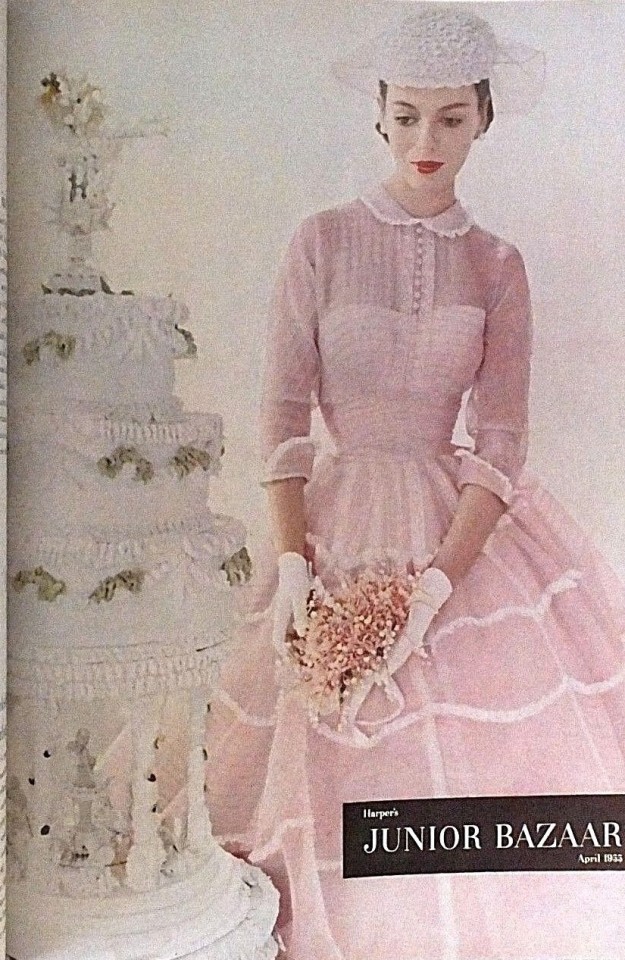
50s/60s Harper's Bazaar
In addition to drawing inspiration from the 50s & 60s Harper's Bazaar & American clothing catalogs, she also drew inspiration from military uniforms and how they have custom buttons and custom fabric and details like that, as well as current trends in London and Tokyo as the brand continued to develop. When she started however, she says that she was the only one making this sort of cute girly clothing in Japan and she felt like she had to make it because no one else was making what she wanted to wear.
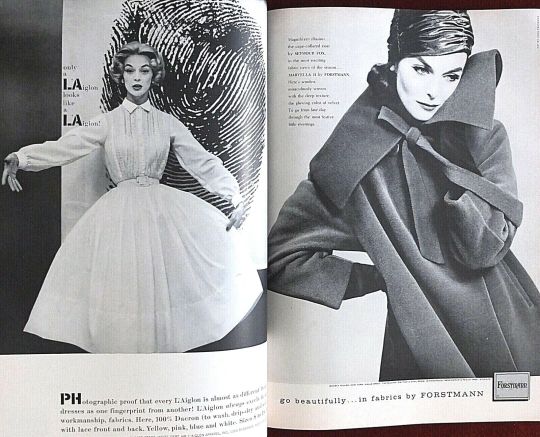

50s/60s Harper's Bazaar
After graduating from Seian College of Art and Design, Department of Design, she started MILK in Harajuku. She wanted to start in the coolest place possible, so she decided on Central Apartment.
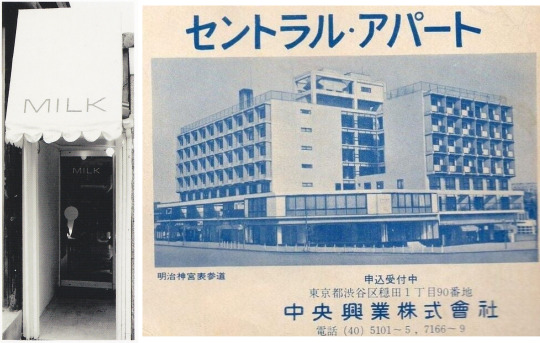
MILK Shop Front in the 70s, Central Apartment
She had come to Harajuku when she was either in High School or her first year of University and had stood in the middle of the pedestrian bridge right off Harajuku station, and she looked down at Omotesando and thought "Here is the coolest place, I want to be here!", and that's why she chose that location. The Bridge doesn't exist any more, it was torn down in 2011. She wasn't aware at the time that Central Apartment was a popular place for creators, she just thought that street was nice and that Central Apartment was modern and cool. In a 2021 interview she confessed that she sometimes still goes up to the pedestrian bridge on the Yoyogi Park side and looks at Omotesando, and when she does, she feels the same way she did when she was 20 years old.
Central Apartment (原宿セントラルアパート) was initially an apartment complex built in Harajuku in 1958 at the intersection of Meiji-dori. It was initially built for special international travelers like US military personnel. In the mid 1960s/early 1970s, the lower floors were converted into stores with offices in the upper apartment floors.
The Coffee shop Leon on the first floor was a popular spot with creative people. There were also shops like Mademoiselle Nonnon launched by designer Taro Aramaki which sold French style clothing and lots of horizontal stripes. Mademoiselle Nonnon is considered to be the source of the border (horizontal stripe) trend in Japan.
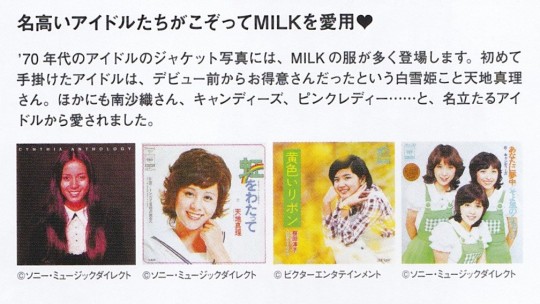
Initially, "MILK", was expensive and unrealistic for everyday wear, so it was mainly used as a stage costume for idols, however, people started wearing Milk as everyday clothing as time went on.
MILK also experimented with a Bridal line in the 70s as well.
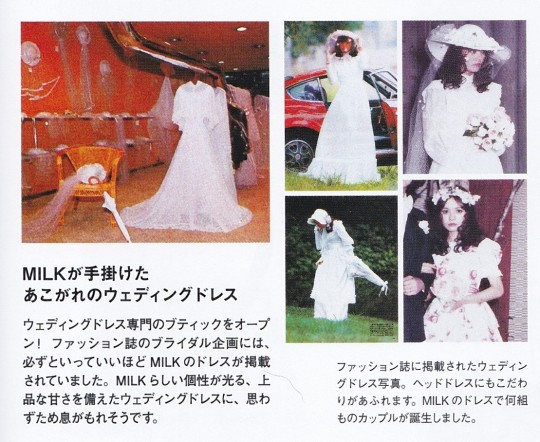
While their runway looks were generally a bit more loud than the way the pieces would have been worn in real life, you can see some prairie revival influence their early 70s items as well as some silhouettes in the '76 collection that are starting to look more lolita-esque.
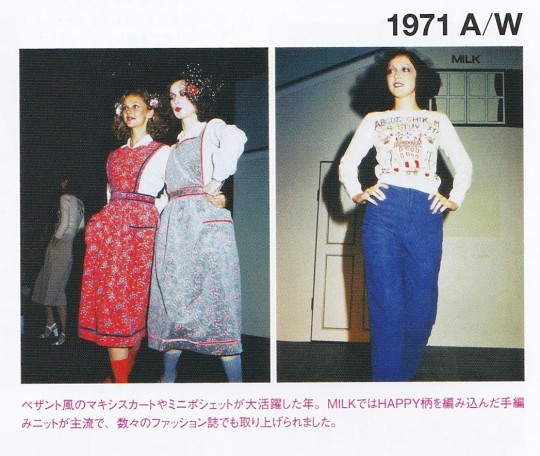
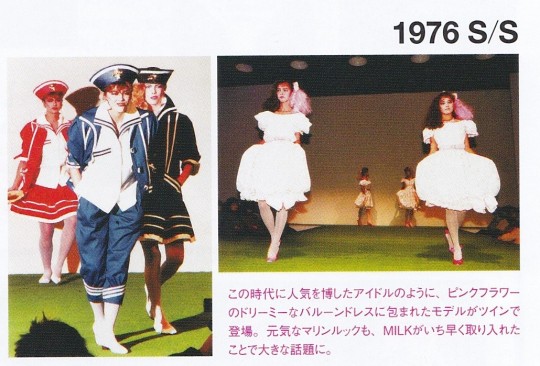
Here are a few runway examples from the 1980s, note the border print of a carousel in the 1988 collection and the knee length ruffled skirt in the 1982 one.
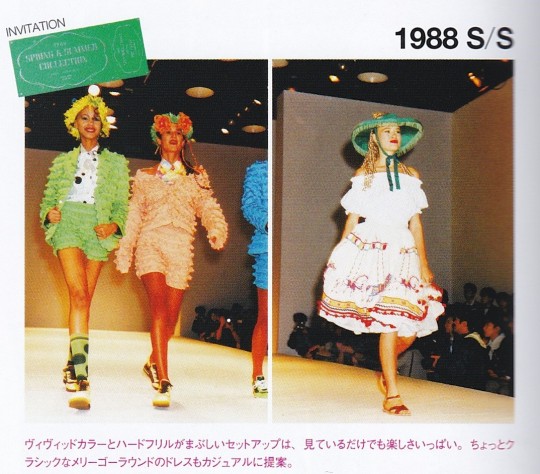

By the early 1990s, MILK was heavily featured in coordinates worn by young women who considered themselves lolita in magazines like Cutie and Zipper, and was also advertising in those magazines.
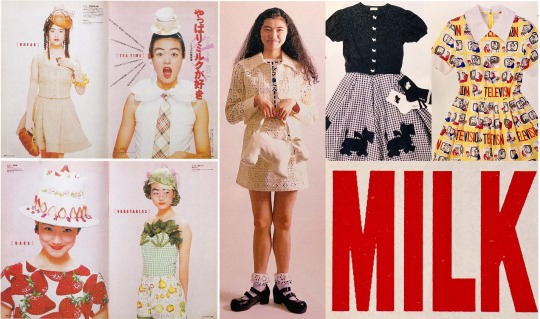
1990-1992 Cutie advertisements for MILK
Early 1990s looks from MILK were fairly consistent with what was on offer from similar shops like PRETTY and Shirley Temple.



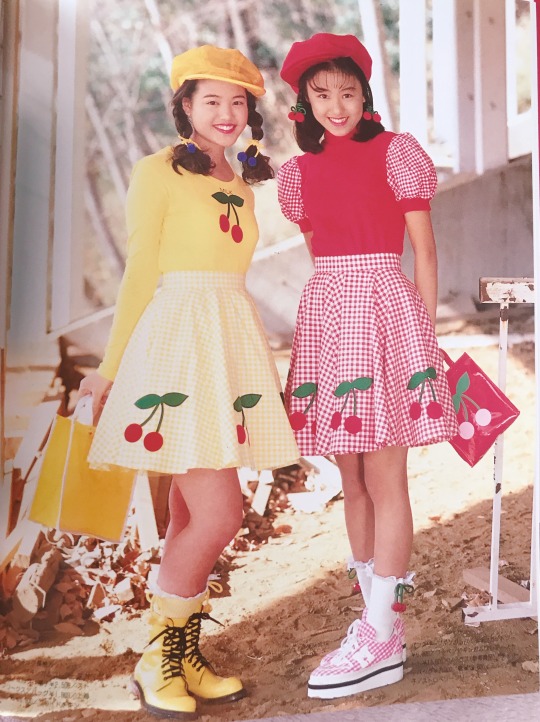
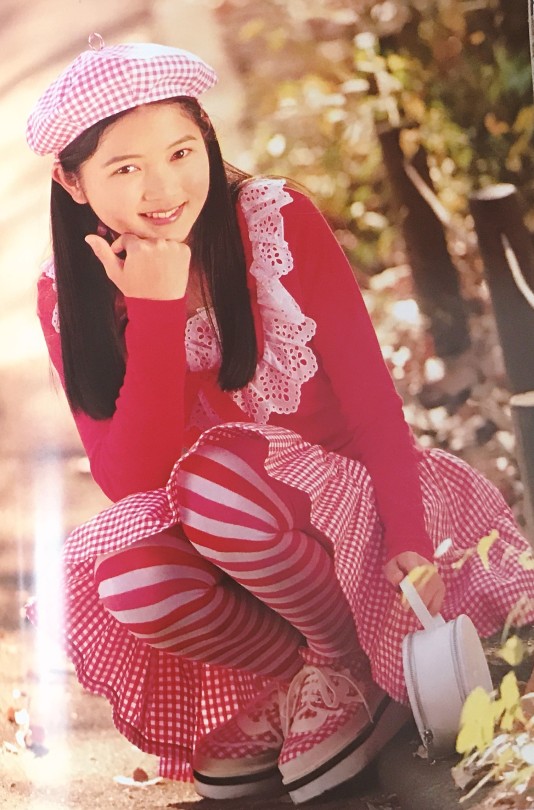

MILK Coordinates from Nene magazine, 1995
Speaking of Shirley Temple, the founder of Shirley Temple, Rei Yanagawa (柳川れい), worked as a designer for MILK before starting the Shirley Temple children's brand in 1974.
As time went on, lolita fashion started to diverge from the MILK style, while MILK followed their own design concept and look more at current trends in girly fashion. Today, some iconic MILK items like their heart purse are still frequently used in lolita fashion, however, it would be difficult to walk into MILK today and put together a coordinate that would read the same as one made from items at Angelic Pretty.
While goth and punk brands typically have no issue relating themselves to goth or punk fashion, brands popular with lolita have sometimes resisted self-describing themselves as lolita, most likely in an attempt to not alienate non lolita customers, due to lolita fashion having a mixed reputation. MILK, like many other Japanese brands, especially DC brands, maintains that they make MILK style, even though their influence on what we call lolita fashion today, is unmistakable.
Past Posts:
Olive Girls
#MILK#Old School Lolita#Lolita Fashion History#Shirley Temple#90s Jfashion#80s Jfashion#70s Jfashion#Lolita History#Central Apartment#Hitomi Okawa#Mini Lolita History Lesson
323 notes
·
View notes
Text
Remember kids, it's only grooming when it's gay.
But for real heres personal story time. Let's talk about actual grooming.
I grew up in the Mormon church in the 90s and early 2000s. Like a good child, I participated in all the church activities including the young women's program. My parents wanted me to do it, i was told the church leaders were good people so I didnt question anything.
While the guys in the boyscouts and young mens program were learning survival skills, learning woodworking, learning how to fix cars, and learning financial literacy ... we were learning to do our makeup, can food, bake bread, sew clothes, cook large meals, and learn about changing diapers. It was hammered in our heads from a young age that our entire purpose in life was to get married, serve the husband, have kids and raise a family.
I remember when I was a Beehive, around 13 or 14, our ward was invited to participate in a fashion show for one of the local bridal stores. They dressed all the young women up, did our makeup and hair, put us in wedding dresses, and invited all the men in the ward to come watch us runway walk in the cultural hall. I was a literal child. I didnt even have tıts yet. Men in their 60s and 70s in our ward came to watch us parade around in our little wedding gowns. That's straight up a pedopagent and grooming child brides, y'all, and I didn't even realize it because things like that were so normalized in the church.
I remember sitting in the bishops office interviewing for my first temple reccomend so I could participate in the young women's activity to do baptisms for the dead. He asks me if I live by the laws of chastity. I was young, naive, sheltered and didn't even know what the word chastity meant. I remember him aggressively, explicitly asking me questions about my virginity- had I ever kissed a boy, touched a boy, thought about a boy, touched myself, touched a girl, thought about a girl, felt tingly down there, had a hymen. He kept asking me over and over if I was sure about my answers, and would elaborate on what he meant like he was fishing for a specific answer. It felt so dirty and invasive. In hind sight it felt more like he was trying to get spank bank material than trying to find out if I was being a "good girl".
Fast forward a few years. Im in Junior High, probably about 15 years old. I'm a closeted homo sitting next to my girlfriend in church, trying my damndest to hold my tongue and not let people catch on that I was crying. The young woman's lesson was about a woman's worth.
They opened up by talking about how we're getting old enough to go to college in a few years and that that's great, but a career and college education should be a hobby and not a goal. They stressed that we shouldn't put our educations and careers as a priority over finding a man, getting married in the temple, and starting a family. They said as soon as we found a man, we needed to drop out and become stay at home mothers. It was the mans duty to provide for the family. We were told that the reason God sent women to this earth to serve men and raise families, and that it was a divine and sacred calling.
The second half was about how lesbians and gay people were sent by the devil to destroy families. We were told if we "struggled with same sex attraction" we needed to pray, repent and try harder to be straight. That we needed to tell the bishop so they could help us get gay conversion therapy. That even if we liked girls, we needed to find a man to marry and bear his children. They actively encouraged gay men and women to catfish straight partners and trick them into thinking you loved them with the purpose of bearing children. Can you imagine how fucking awful it would be to fall in love and marry a person thinking they felt the same way, only to find out they're gay and living a lie so they don't go to hell?
The church advocating "its ok to be gay but you have to be celibate and single for the rest of your life" was a change the church made a few years later when Prop 8 passed and their members started leaving in hoards.
Meanwhile I've been to drag shows since I was in high-school. It's just a bunch of people with great makeup skills doing lavish impressions of Lady Gaga and Freddy Mercury.
Why is a drag show considered grooming but telling actual children that theyre going to be mommies and daddies when they grow up not? Why is it grooming if a trans person is out in public doing something mundane like grocery shopping, but it isn't grooming watching television shows that has love triangle plotlines that revolve around teenagers making out and exploring their sexuality? Why is it grooming when a children's show has a character with two daddies but not grooming when the children's show character has a mom and a dad?
If people really give a shit about grooming, they need to start in their own backyard. Start by deconstructing straight representation in media. Start by asking why its ok to joke that a toddler is going to be a ladies man when he grows up. Start by asking why child beauty pagents even exist. Start by looking at how your religion teaches and enforces sexuality. Start with comprehensive and age appropriate lessons about the human body and consent with little Suzy so when uncle Bob is being inappropriate at the family reunion she has the knowlege and tools to know whats going on, to assert her boundaries, and the confidence to tell another grownup what's going on.

77 notes
·
View notes
Text
Christian Lacroix Spring 1994 Couture Collection
Christian Lacroix Spring 1994 Couture Collection
Christian Lacroix Spring 1994 Couture collection, runway looks, beauty, models, and reviews.
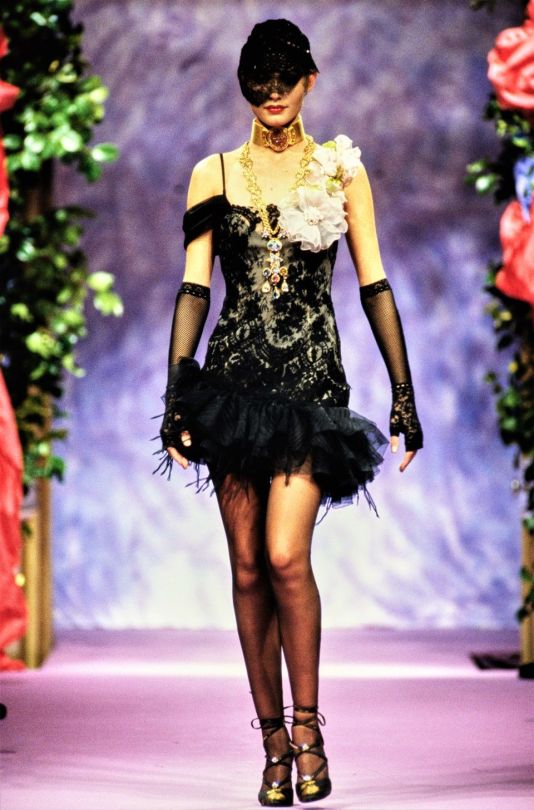
HCM (@hoodcouturemag) / Twitter

Christian Lacroix Spring 2006 Couture Fashion Show
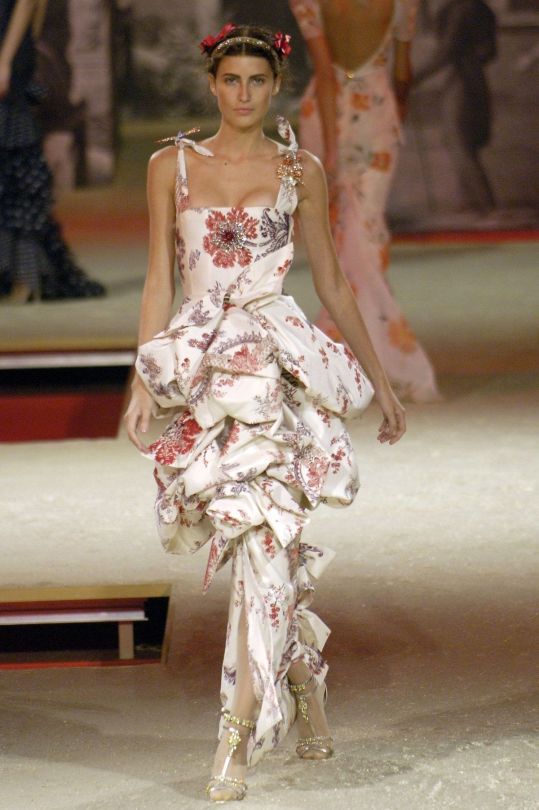
Christian Lacroix’s Glorious Couture From the Vogue Archive
A selection of the designer's couture gems from the Vogue archive.
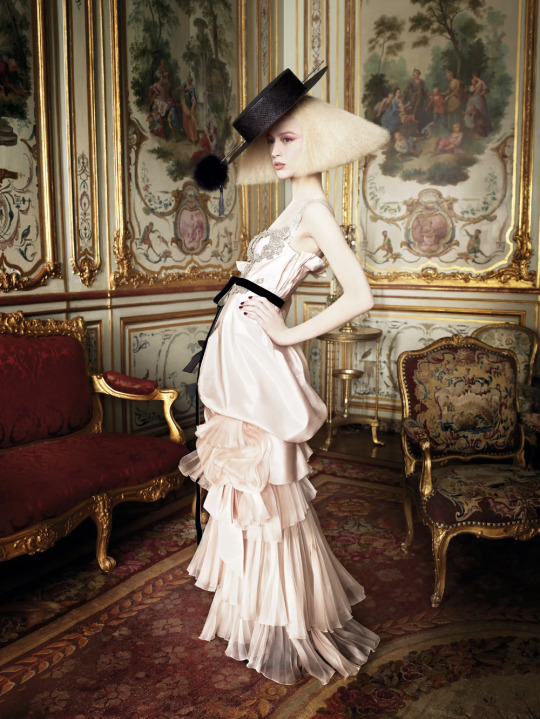
Christian Lacroix Haute Couture Spring-Summer 2006
Explore Christian_Lacroix's 1574 photos on Flickr!
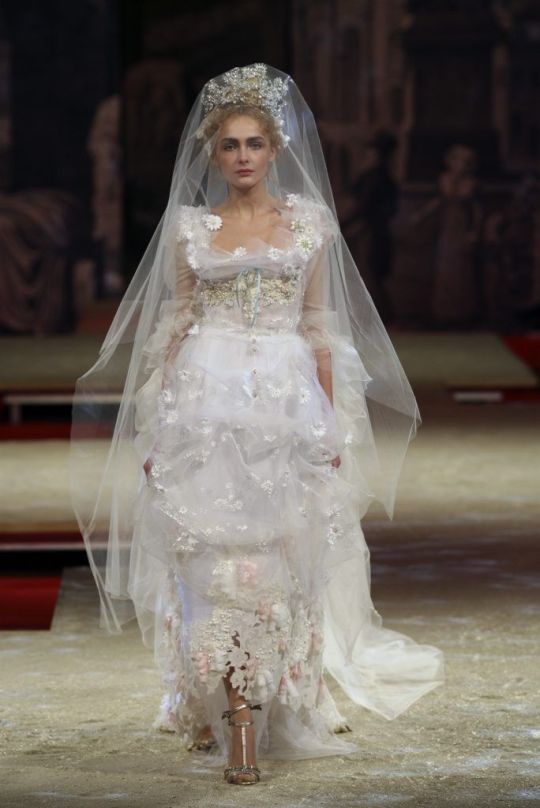
Christian Lacroix Spring 1988 Couture Collection
Christian Lacroix Spring 1988 Couture collection, runway looks, beauty, models, and reviews.

Christian Lacroix Fall 2005 Couture Fashion Show

Editor’s note: Vogue Runway is celebrating “the most wonderful time of the year” by adding six magical—and newly digitized—1990s haute couture shows to our archive. Christian Lacroix’s spring 1994 collection was originally presented on January 16, 1996, at the Hotel Intercontinental in Paris.“Spring ’94 was a mix and match of French Revolution and Directoire styles with 1940 fashions—my two favorite periods in costume history—in ’90s proportions.” —Christian Lacroix“Today, femininity is a weapon; it’s a force.” So said Christian Lacroix about his spring 1994 show to Vogue. Despite a few borrowed-from-the-boys nautical elements, and the casting of the androgynous and shaved-head model Eve Salvail, the collection was anything but hard-edged. In fact, it served as a brief respite from calamity. An earthquake in Los Angeles and an attack on the figure skater Nancy Kerrigan were among the events that took place in the buildup to the season, leading Lacroix to include the following lines, quoted by the Associated Press, in his program notes: “In these violent and desperate times, the only salvation lies in sincerity and a total loyalty towards one’s passions. Couture is my passion.”Lacroix channeled his passions in a number of directions here, as he explored, per Vogue, “three stylistically liberated times in history—1800, the mid-1940s, and 1980.” You really have to dig for references to the “greed decade,” in which Lacroix made his debut, but the ’40s clearly influenced the hair and makeup.“The bride was inspired by an 18th-century engraving of the Virgin Mary, and was embroidered with fabrics and real stones François Lesage, my godfather, gifted me, and which are still in my bedroom.” —LacroixLacroix’s ardor for historical references equaled, if not topped, his passion for couture, as is expressed in the penultimate bridal look featuring a floral-stripe and beaded corset worn with a metallic lace underskirt on top of which was another skirt of a pale plaid with lace appliqués over which skim embroidered songbirds. Call it a cut-and-paste assemblage, the couture way. Fantastical in another mode were the more contemporary yet still dreamy lingerie looks that move beyond the ubiquitous 1990s slip dress.
3 notes
·
View notes
Link
Check out this listing I just added to my Poshmark closet: Glitter platform Barbie wedding bridal shoes 90s pink floral rosé vintage y2k.
0 notes
